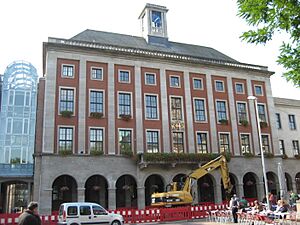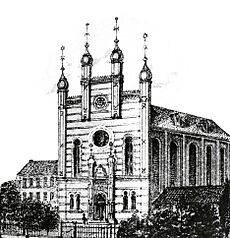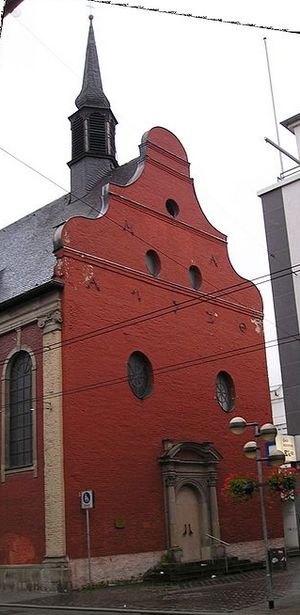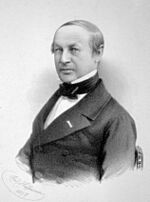Neuss facts for kids
Quick facts for kids
Neuss
|
|||
|---|---|---|---|

Town hall
|
|||
|
|||
| Country | Germany | ||
| State | North Rhine-Westphalia | ||
| Admin. region | Düsseldorf | ||
| District | Rhein-Kreis Neuss | ||
| Elevation | 40 m (130 ft) | ||
| Population
(2022-12-31)
|
|||
| • Total | 154,139 | ||
| Time zone | CET/CEST (UTC+1/+2) | ||
| Postal codes |
41460-41472
|
||
| Dialling codes | 02131, 02137 (Norf), 02182 | ||
| Vehicle registration | NE | ||
| Website | www.neuss.de | ||
Neuss is a city in North Rhine-Westphalia, Germany. It is located on the west side of the Rhine River, across from Düsseldorf. Neuss is the biggest city in the Rhein-Kreis Neuss district.
The city is famous for its old Roman sites. It also hosts the yearly Neusser Bürger-Schützenfest, a large marksmen's festival. Neuss and Trier are both known as "Germany's oldest city." In 1984, Neuss celebrated its 2000th birthday, as it was founded in 16 BCE.
Contents
History
Roman times
Neuss was started by the Romans in 16 BC. It began as a military fort called castrum (a Roman army camp). The city grew north of this camp, where the Rhine and Erft rivers meet. The Romans called it Novaesium.
The Legio XVI Gallica (16th Gallic Legion) of the Roman army was stationed here from 43 to 70 AD. This legion was disbanded after they surrendered during the Batavian rebellion in 70 AD.
Later, a town for regular people was built in the area of today's city center. This happened during the 1st century AD. Novaesium, along with Trier, is one of the three oldest Roman settlements in Germany.
Middle Ages
Neuss grew a lot during the Middle Ages. This was because it was in a great spot, near important travel routes and with its own harbour and ferry. In the 10th century, the remains of Saint Quirinus were moved to Neuss. He was a martyr and a Roman officer. This made Neuss a popular place for pilgrimage (religious journeys). People came from far away to visit the shrine of St. Quirinus. Neuss was first officially called a town in 1138.
A very important event in the city's history was the siege in 1474–75. Charles the Bold, the Duke of Burgundy, tried to capture the town. The siege lasted for almost a year. But the people of Neuss bravely defended their city. Because of their courage, the Holy Roman Emperor Frederick III rewarded them. The town was allowed to make its own coins. It could also use the imperial coat of arms, which included the imperial eagle and crown, in its own city symbol. Neuss also became a member of the Hanseatic League, a powerful group of trading cities.
Early modern times
In 1586, a big fire destroyed more than two-thirds of Neuss. Later, several wars during the time of King Louis XIV of France made the city's money problems worse. Neuss quickly lost its importance as a trading center. From the mid-1600s onwards, Neuss became a city mostly known for its farming.
Until the late 1700s, Neuss was part of the Electorate of Cologne. This was a powerful region ruled by an archbishop. From 1794 to 1814, Neuss was part of France under Napoleon. After the Napoleonic Wars ended in 1815, Neuss became part of the Kingdom of Prussia. It was then made into a district with several smaller towns. At that time, Neuss had about 6,333 people. It was part of the Prussian Province of Jülich-Cleves-Berg and later the Rhine Province.
19th century to today
Neuss became strong again economically in the 1800s. Its harbor was made bigger in 1835, and more factories started to open. The city's borders grew in 1881. In 1946, Neuss became part of the new state of North Rhine-Westphalia.
In 1968, the spelling of the city's name changed from Neuß to Neuss. In 1975, the city of Neuss and the district of Grevenbroich joined together. They formed the district of Rhein-Kreis Neuss. This new district had about 440,000 people, and its main government office is in Neuss. Neuss is also home to Toshiba's main office for Europe.
| Largest groups of foreign residents | |
| Nationality | Population (2018) |
|---|---|
| 5,440 | |
| 1,775 | |
| 1,627 | |
| 1,132 | |
| 1,088 | |
| 1,072 | |
| 982 | |
| 829 | |
Jewish history
A Jewish community has lived in Neuss since the High Middle Ages. The first records of Jews in the city are from 1096. At that time, Jews from Cologne were escaping Crusaders. The Archbishop of Cologne Hermann III gave them shelter in Neuss. However, about 200 of them were killed by Crusaders. This happened during the terrible events known as the Rhineland massacres.
There is no clear sign that Neuss had an organized Jewish community in 1096. But it is certain that one existed from the late 12th century onwards. This was when many merchants, including Jews, moved into the city.
In the High Middle Ages, the Jewish community first lived near the merchants. This area was between the haven (port) and the market. The path to the port was called the Judensteg. By the year 1300, Christians lived in the Judensteg area. The Jews had moved to the area around the Glockhammer. Their synagogue (place of worship) and school were also there. This area was not a ghetto because it was not closed off. Christians also lived there.
From the 14th century, Jews faced more competition for jobs and businesses. First, they lost their good location near the docks. Later, they lost their special role in lending money. This happened when bankers from Lombardy and Cahors arrived.
The city was hit by the Black Death in 1348-49. The Jewish community suffered greatly during this time. They faced terrible persecutions, just like in other parts of Europe. After the plague, the community was much smaller and had less money. A wave of extreme religious ideas and intolerance spread. Jews faced more pressure and became part of political fights. In 1424, Jews were forced to leave the city for a while. This was a way to challenge the Landesherr, who was supposed to protect the Jews.
The Jews later came back. But they were finally expelled again in 1464. The Archbishop of Cologne Ruprecht von der Pfalz visited the city. He tried to stop the expulsion, but he could not. From then on, Jews were not allowed to live in Neuss. They could not even stay overnight inside the city walls. In 1694, Jews were allowed to hold a cattle market outside the Obertor. In 1704, the city started a special tax for Jews entering the city. It was called the Judenleibzoll.

In 1794, Neuss came under French control during the War of the First Coalition. All unfair laws against Jews were then removed. But it was not until 1808 that a Jewish family moved to the city again. This was the family of Josef Großmann, a butcher from Hülchrath. The community slowly grew. In 1830, there were about 100 Jews out of a total population of 8,000. The community continued to grow throughout the century.
Jews who moved to Neuss often came from nearby farming areas. Because of this, they were more traditional than Jews in other German cities. New ideas from the Haskalah (Jewish Enlightenment), like religious services in German, did not become popular here. Services continued to be held in Hebrew. Generally, Jews in Neuss were more religious than in other German cities.
Relations between Jews and Christians were usually good at this time. They lived side by side. Christians would even help Jewish neighbors with tasks not allowed on Shabbat (the Jewish day of rest).
However, this peace was broken in 1834. Rumors of blood libel (false accusations against Jews) spread in the Niederrhein area. This led to anti-Jewish unrest. Synagogues were set on fire in some towns. In other places, there were fights between angry groups and soldiers. Neuss was also affected. Crowds walked through the streets singing anti-Jewish songs. This unrest lasted for days until soldiers were brought in to stop it.
On March 29, 1867, the Synagogue was opened. It was designed by Friedrich Weise, a Prussian architect. It was built in the popular Orientalist style. The city celebrated its opening for three days. Even though it served only about 1% of the population, the Synagogue was a proud landmark in Neuss. The synagogue community reached its largest size with 316 members in 1890.
In 1933, there were only 227 Jewish citizens left in Neuss. From that year on, they faced increasing persecution by the Nazis. Few managed to leave the country in time. Then began the systematic persecution and deportation of Jews. On July 22, 1942, the last Jewish resident from Küpperstaße 2 was put on a train from Aachen to Theresienstadt. On November 23, 1942, Neuss was declared Judenrein (meaning "clean" of Jews).
However, a small number of Jews survived by hiding. Others were not targeted because they were married to non-Jewish people.
The exact number of Jewish victims of the Nazi regime is not fully known. But you can find the names of 204 murdered Jews who had a connection to Neuss on a monument by Ulrich Rückriem. Many Stolpersteine (small memorial plaques) can also be found around the city.
Since the 1990s, the community has grown again. This is thanks to Jews moving from the former Soviet Union. In 2021, it was thought that about 550 Jews lived in Neuss.
Number of inhabitants
- 1798: 4,423
- 1831: 7,888
- 1861: 10,300
- 1885: 20,074
- 1900: 28,472
- 1925: 44,958
- 1945: 51,624
- 1965: 111,104
- 1987: 142,178
- 2015: 159,672
Sports
One sports club in Neuss is Neusser Schlittschuh-Klub. They have sections for figure skating and ice stock sport. They are also the only club in Germany that plays bandy. Since there isn't a large ice surface, they practice a type of bandy called rink bandy. There are also two football clubs in Neuss: VfR Neuss Football Club and DJK Novesia Neuss. The city also has an American Football team called Neuss Legions American Football.
Places to visit
- Botanischer Garten der Stadt Neuss: This is the city's botanical garden, full of different plants.
- Basilica of St. Quirinus: This is a church built in the 13th century. It is a late Romanesque style church. It is dedicated to the city's patron saint and holds his relics. Its dome-shaped eastern tower is a famous landmark. In 2009, it was given the special title of minor basilica.
- Obertor (Upper Gate): This is the southern city gate, built around 1200. Today, it is part of the Clemens Sels Museum Neuss. It is the only one left of the six original gates that were part of the old city walls.
- Blutturm (Bloody Tower): This tower was built in the 13th century. It is the only round tower left from the historic city walls.
- Zum "Schwatte Päd" (The Black Horse): This is the oldest public house (pub) in the Lower Rhine region. It was opened in 1604.
- Saint Sebastianus Church
- Saint Maria Church
- Christuskirche (Christ church): This is an historicistic church. It is the city's oldest Protestant church.
- Globe Theater: This is a copy of the famous London Globe Theatre. It hosts an annual Shakespeare festival.
- Hamtor/the Hamgate
- Neusser Bürger-Schützenfest: This is one of Germany's largest marksmen's festivals. It happens every year on the last weekend in August. About 7,000 marksmen take part in the traditional parades.
Famous people from Neuss
- Hildegund (virgin) (1170–1188), a saint
- Johann Pennarius (1517–1563), an auxiliary bishop in Cologne
- Hermann Thyraeus (1532–1591), a theologian and member of the Society of Jesus
- Peter Thyraeus, (1546–1601), a Jesuit and professor of theology
- Theodor Schwann (1810–1882), a physiologist
- Franz Maria Feldhaus (1874–1957), a historian of technology and writer
- Katharina von Oheimb (1879-1962), a politician
- Joseph Frings (1887–1978), an Archbishop of Cologne
- Kurt Josten (1912–1994), a German-British lawyer and resistance fighter
- Erik Martin (1936–2017), an author, songwriter, and editor
- Mario Ohoven (born 1946), a financial expert
- Elke Aberle (born 1950), an actress
- Friedhelm Funkel (born 1953), a football player and coach
- Heike Hohlbein (born 1954), a writer
- Jürgen P. Rabe (born 1955), a physicist
- Norbert Hummelt (born 1962), a writer
- Kai Böcking (born 1964), a TV presenter
- Franziska Pigulla (1964–2019), an actress and news presenter
- Frank Biela (born 1964), a racing driver
- Mònica Oltra (born 1969), a Spanish politician
- Thomas Rupprath (born 1977), a swimmer
- Lars Börgeling (born 1979), a pole vaulter
- Judith Flemig (born 1979), a volleyball player
- Jawed Karim (born 1979), an American entrepreneur and co-founder of YouTube; he lived here from about 1981 to 1992
- Dirk Caspers (born 1980), a former football player
- Marcel Ohmann (born 1991), an ice hockey player
- Danny da Costa (born 1993), a footballer
Twin towns – sister cities
Neuss is twinned with these cities:
 Châlons-en-Champagne, France (since 1972)
Châlons-en-Champagne, France (since 1972) Pskov, Russia (since 1990)
Pskov, Russia (since 1990) Rijeka, Croatia (since 1990)
Rijeka, Croatia (since 1990) Saint Paul, United States (since 1999)
Saint Paul, United States (since 1999) Nevşehir, Turkey (since 2007)
Nevşehir, Turkey (since 2007)
Gallery
See also
 In Spanish: Neuss para niños
In Spanish: Neuss para niños











